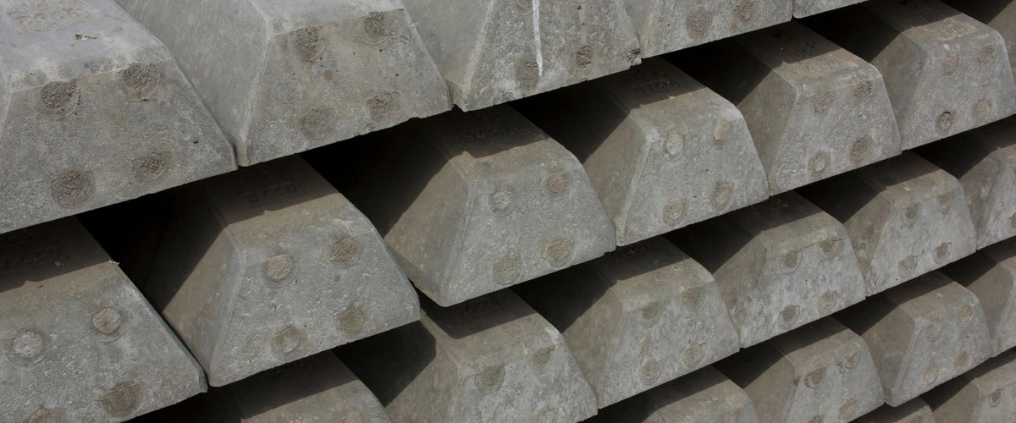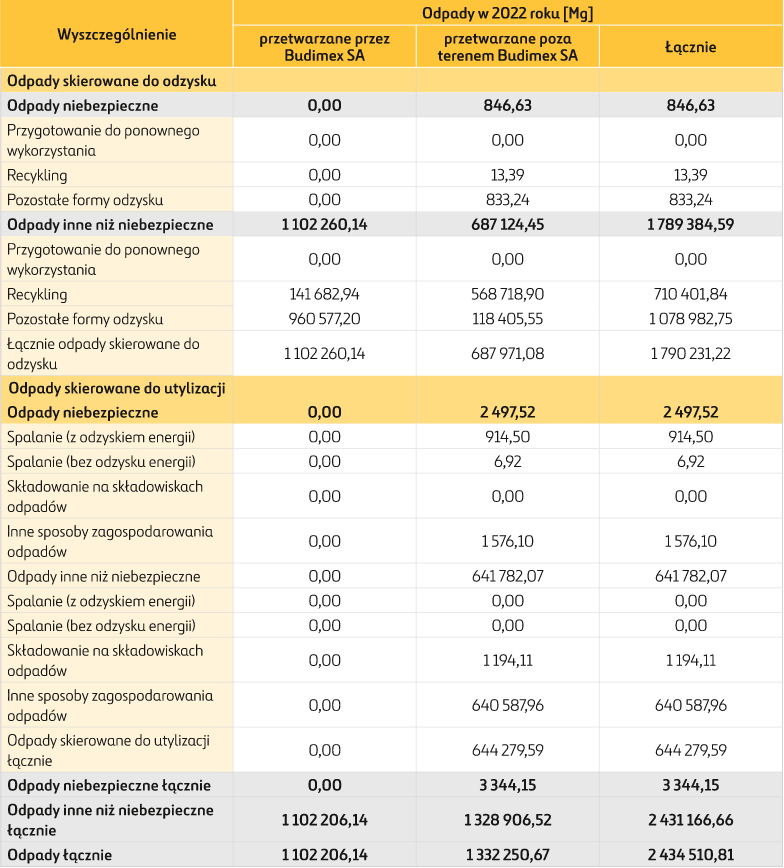[GRI 301-1] [GRI 306-1] [GRI 306-3] [GRI 306-4] [GRI 306-5]
Waste
This section presents waste in a breakdown in line with GRI 306. The data is summarised in Table No. 20.
Table 17. Waste generated year-on-year.

In 2022, there is an increase in hazardous waste of 18.7% at a consolidated level. The resulting differences in the amount of waste generated in 2021 and 2022 are due to the type of works carried out in these years and the waste generated by these works (especially railway sleepers).

Construction waste mainly comes from demolition and renovation works, and its total amount depends on the number of contracts and their progress. Waste management on construction sites is regulated by the ‘Waste Management Plan’ contained in the Safety and Health Plan. The breakdown of waste generated by Budimex SA is presented in Table No. 18 Budimex SA waste information breakdown.
If hazardous waste is generated in the course of works, the contractor is obliged to store and manage such waste safely for health and the environment, and to respond to emergency situations. Proper waste management on construction sites is supervised by Site Managers with the support of the Budimex SA Environmental Department.
At each stage of construction, waste specific to the type of work carried out is generated. Brick and concrete rubble is mainly generated at the stage of demolition of facilities at the location where the new development will be built, while asphalt pulveriser and track ballast waste are generated after road and track demolition. The most commonly generated wastes are soil and earth waste and rubble, stones, as well as waste from the repair and dismantling of buildings and road infrastructure. Many of them can be re-used at subsequent stages of works. The soil removed is a valuable raw material that may be applied in finishing works. Shrubs and branches from felling (if unavoidable), on the other hand, can be used as gardening material.
Waste generated on construction sites is increasingly being used commercially (e.g. concrete from demolition, which can be used as aggregate, asphalt pulp removed – asphalt waste used in construction processes, as part of road reconstruction or rehabilitation, including hardening of yards and roadsides or airport infrastructure). During construction and demolition work, metals, wood, glass, rubble, soil and earth and ballast, among others, are segregated.
Table 18. Breakdown of Budimex SA waste information. [GRI 306-4]

Budimex SA attaches great importance to the reprocessing and use of materials and waste. The non-hazardous waste processed by the Company loses its waste status and, as a post-recovery material, including recycling, is returned to the closed-loop process by being re-built during the course of construction works, after its suitability has been tested beforehand. In 2022, 45.3% of the non-hazardous waste generated was returned to the closed-loop process on the Company’s projects. In addition, 28.3% of the non-hazardous waste generated was sent for recovery outside Budimex SA.
Waste generated by Mostostal Kraków SA is included in Table No. 20 Waste information breakdown – Budimex Capital Group.
ProWaste treatment processes are carried out at the mechanical-biological processing (MBP) systems and at landfills. Waste processing at MBP systems is carried out through mechanical and biological processes. In the mechanical part of the system, it is carried out on a sorting line that makes it possible to separate recyclable and recoverable waste, as well as the major fraction (which is then sent to authorised recipients) and the minor fraction processed in the biological part of the system in an aerobic stabilisation process conducted in bioreactors and a maturation yard. The waste generated by these processes, depending on its type and properties, is sent for recovery or neutralisation. The FBSerwis Group operates two landfills for non-hazardous and inert waste and one landfill for hazardous waste containing asbestos. Once accepted at the landfill, the waste is disposed of by being placed in the quarters of the landfill. Some waste is used in landfills to create containment and reclamation layers, to create landfill slopes or to pave access roads. A summary of the waste processed is presented in Table No. 19 Waste information breakdown processed in the FB Service Group.
Table 19. Waste information breakdown processed in the FB Serwis Group. [GRI 306-4]

Waste information breakdown for the Budimex Group can be found in Table No. 20 Waste information breakdown – Budimex Group.
Table 20. Waste information breakdown – Budimex Capital Group. [GRI 306-4]


